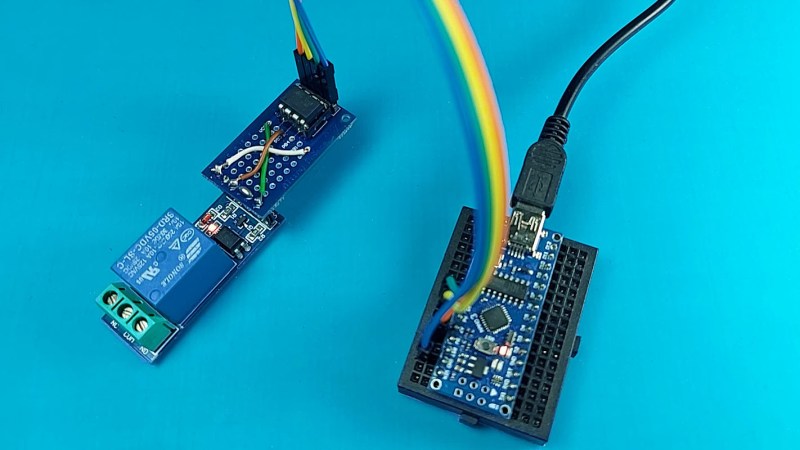I2C To The Max With ATtiny

The Arudino is a powerful platform for interfacing with the real world, but it isn’t without limits. One of those hard limits, even for the Arduino MEGA, is a finite …read more Continue reading I2C To The Max With ATtiny
Collaborate Disseminate

The Arudino is a powerful platform for interfacing with the real world, but it isn’t without limits. One of those hard limits, even for the Arduino MEGA, is a finite …read more Continue reading I2C To The Max With ATtiny

Biohacking projects are not new to Hackaday and it’s certainly a genre that really piques our interest. Our latest biohacking device comes courtesy of [Manivannan] who brings his flavor of …read more Continue reading A DIY Biometric Device with Some Security Considerations
With innumerable microcontroller boards on the market it’s sure that there will be one for every conceivable application or user. Among them are some seriously tiny ones, but this wasn’t enough for [Alun Morris]. Wanting to see how small he …read more
Continue reading How Tiny Can A Microcontroller Dev Board Be!
It’s a little known secret that when the Hackaday writers gather in their secret underground bunker to work on our plans for world domination, we often take breaks to play our version of the corporate “Buzzword Bingo”, where paradigms are …read more
Continue reading Arduino Wannabe Should Have Used a 555. Oh Wait, It Does.
“Sorry. I had music playing. Would you say that again?” If we had a money-unit every time someone tried talking to us while we were wearing headphones, we could afford a super-nice pair. For an Embedded C class, [extremerockets] built Listen Up!, a cutoff switch that pauses your music …read more
Continue reading Pause Your Tunes When it is Time to Listen Up!
One of the step changes in electronic construction at our level over the last ten or fifteen years has been the availability of cheap high-quality printed circuit boards. What used to cost hundreds of dollars is now essentially an impulse buy, allowing the most intricate of devices to be easily …read more
Continue reading This Home-Etched ARM Dev Board Is A Work Of Art
When you think of microcontroller development, you probably picture either a breadboard with a chip or a USB-connected circuit board. But Tim Ansell pictured an ARM dev board that is almost completely hidden inside of a USB port. His talk at the 2018 Hackaday Superconference tells that story and then some. Check out the newly published video, along with more details of the talk, after the break.
Tim is the creator of Tomu, the tiny ARM Cortex M0+ board that we first covered back in January. The board has a Silicon Labs EMF32 on one side, four traces to interface …read more
Continue reading How a Microcontroller Hiding in a USB Port Became an FPGA Hiding in the Same
Readers of Hackaday are no strangers to using a microcontroller to push data to WiFi. Even before the ESP8266 there were a variety of ways to do that. Now Microchip is joining the fray with a $29 board called the AVR-IOT WG that contains an 8-bit ATmega4808, a WiFi controller, and hardware-based crypto chip for authenticating with Google Cloud.
The board has a section with a USB port for charging a battery and debugging that looks like it is made to cut away. There are a number of LEDs and buttons along with a light sensor and a temperature sensor. …read more
If you’re at all like us, or like [Vadim], you’ve got a stash of development boards in a shoebox on a shelf in your closet. If you’re better organized that we are, it might even be labeled “dev boards”. (Ah well, that’s a project for another day.) Anyway, reach into your box and pull one out, and put it to use. Do something trivial if you need to, but a dev board that’s driving a silly blinker is better than a dev board sitting in the dark.
[Vadim]’s good example to us all is going to serve as the brains …read more
![]() Continue reading Making Use of Stellaris/Tiva Real-Time Clock
Continue reading Making Use of Stellaris/Tiva Real-Time Clock
If you’re at all like us, or like [Vadim], you’ve got a stash of development boards in a shoebox on a shelf in your closet. If you’re better organized that we are, it might even be labeled “dev boards”. (Ah well, that’s a project for another day.) Anyway, reach into your box and pull one out, and put it to use. Do something trivial if you need to, but a dev board that’s driving a silly blinker is better than a dev board sitting in the dark.
[Vadim]’s good example to us all is going to serve as the brains …read more
![]() Continue reading Making Use of Stellaris/Tiva Real-Time Clock
Continue reading Making Use of Stellaris/Tiva Real-Time Clock